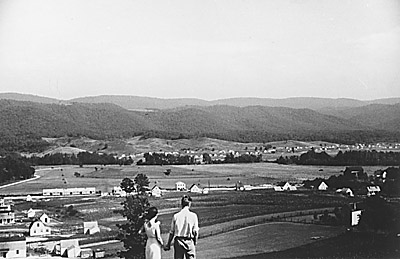Tygart Valley Homestead
New Deal Communities in Randolph County
By Kathy Roberts

A young couple gazes across the newly built Tygart Valley Homestead in Randolph County in 1936, comprising the communities of Dailey, East Dailey, and Valley Bend. Photograph by Carl Mydans, Farm Security Administration/Library of Congress. Courtesy of the West Virginia State Archives.
The Great Depression hit West Virginia early and hard. When the bottom fell out of the coal and timber industries in the early 1930's, it left thousands around the state jobless, homeless, and hungry.
Beth (Guye) Kittle of Elkins recalls those days well. In 1933, Beth, her two brothers, and her parents moved from Pittsburgh back to West Virginia to live with her maternal grandmother in Montrose, Tucker County. “My father lost his job with the Pennsylvania railroad,” Beth remembers. “We couldn’t pay rent, and they came and took our furniture.” For the next three years, the family stayed with her grandmother while Beth’s father searched for work out of state.
That same year, the Roosevelt Administration established the Federal Subsistence Homestead Division, which oversaw the development of self-sustaining communities for unemployed industrial workers throughout the nation. These homesteads provided employment opportunities, farmland, and modern, affordable housing for some 25,000 families during the Great Depression. West Virginia was home to three of these homestead communities. They were located in Preston County (Arthurdale), Putnam County (Eleanor), and Randolph County (Tygart Valley Homestead). All were initiated between 1932 and 1934.
Beth Kittle was 10 years old in 1936 when her family moved to their new five-room house on plot H-18 in the Valley Bend community at the Tygart Valley Homestead. “It was exhilarating,” she recalls. At first, Beth stayed with her grandmother while the family settled into their new home. “Grady, my brother, wrote me a letter when I was with Grandmother there,” Beth recalls. “And he said,‘Guess what? We have a machine that makes ice cubes!’ We didn’t have a refrigerator at Grandmother’s. In fact, I didn’t know what a refrigerator was. I was anxious to get to Valley Bend and see this wonderful machine.”
The Tygart Valley Homestead was developed on approximately 2,500 acres of farmland between Rich and Cheat mountains, about 10 miles south of Elkins. Located along U.S. Route 219, the Homestead is made up of three small communities — Dailey, East Dailey, and Valley Bend — and a commercial/industrial center.
At Dailey, a lumber mill provided steady work for a ready and willing labor force. Also along Route 219 at Dailey, the Homestead Trade Center housed a restaurant, beauty shop, dentist office, dance hall, post office, and cooperative store. Nearby, a weaving shop, woodworking shop, and community toolshed facilitated the development of artisan skills.
Each of the 198 houses at the Homestead was built on a generous plot of land, ranging in size from 1.72 to 2.5 acres. The attractive, stylish housing and the outbuilding complexes on the Homestead enabled a progressive middle-class lifestyle, while at the same time facilitated subsistence agricultural practices.
The compact, two-story houses were constructed of plaster and redwood frame, and featured oak flooring, knotty pine paneling, and exposed chestnut beams.
You can read the rest of this article in this issue of Goldenseal, available in bookstores, libraries or direct from Goldenseal.